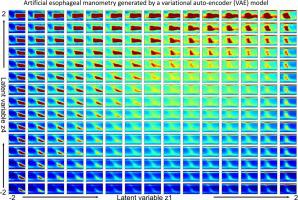Artificial Intelligence in Medicine ( IF 6.1 ) Pub Date : 2021-01-05 , DOI: 10.1016/j.artmed.2020.102006 Wenjun Kou 1 , Dustin A Carlson 1 , Alexandra J Baumann 1 , Erica Donnan 1 , Yuan Luo 2 , John E Pandolfino 1 , Mozziyar Etemadi 3

|
High-resolution manometry (HRM) is the primary method for diagnosing esophageal motility disorders and its interpretation and classification are based on variables (features) from data of each swallow. Modeling and learning the semantics directly from raw swallow data could not only help automate the feature extraction, but also alleviate the bias from pre-defined features. With more than 32-thousand raw swallow data, a generative model using the approach of variational auto-encoder (VAE) was developed, which, to our knowledge, is the first deep-learning-based unsupervised model on raw esophageal manometry data. The VAE model was reformulated to include different types of loss motivated by domain knowledge and tuned with different hyper-parameters. Training of the VAE model was found sensitive on the learning rate and hence the evidence lower bound objective (ELBO) was further scaled by the data dimension. Case studies showed that the dimensionality of latent space have a big impact on the learned semantics. In particular, cases with 4-dimensional latent variables were found to encode various physiologically meaningful contraction patterns, including strength, propagation pattern as well as sphincter relaxation. Cases with so-called hybrid L2 loss seemed to better capture the coherence of contraction/relaxation transition. Discriminating capability was further evaluated using simple linear discriminative analysis (LDA) on predicting swallow type and swallow pressurization, which yields clustering patterns consistent with clinical impression. The current work on modeling and understanding swallow-level data will guide the development of study-level models for automatic diagnosis as the next stage.
中文翻译:

使用变分自编码器的基于深度学习的食管测压无监督模型
高分辨率测压 (HRM) 是诊断食管动力障碍的主要方法,其解释和分类基于每次吞咽数据的变量(特征)。直接从原始燕子数据中建模和学习语义不仅可以帮助自动化特征提取,还可以减轻预定义特征的偏差。使用超过 32,000 个原始吞咽数据,开发了一个使用变分自动编码器 (VAE) 方法的生成模型,据我们所知,这是第一个基于深度学习的原始食管测压数据的无监督模型。VAE 模型被重新制定,以包括由领域知识驱动的不同类型的损失,并使用不同的超参数进行调整。发现 VAE 模型的训练对学习率很敏感,因此证据下限目标 (ELBO) 被数据维度进一步缩放。案例研究表明,潜在空间的维度对学习的语义有很大的影响。特别是,发现具有 4 维潜在变量的病例可以编码各种具有生理意义的收缩模式,包括强度、传播模式以及括约肌松弛。所谓的混合 L2 损失的案例似乎更好地捕捉到收缩/松弛过渡的连贯性。使用简单线性判别分析 (LDA) 对预测吞咽类型和吞咽加压进一步评估辨别能力,从而产生与临床印象一致的聚类模式。











































 京公网安备 11010802027423号
京公网安备 11010802027423号